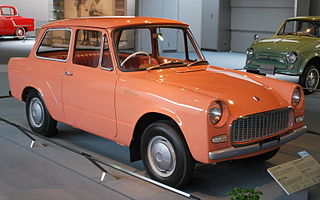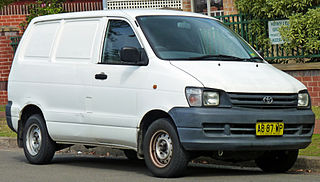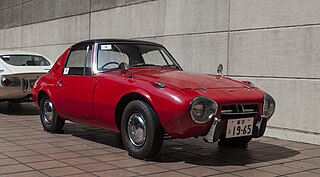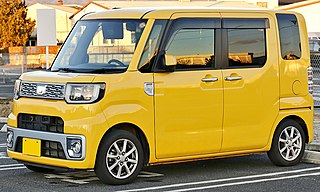
Daihatsu Motor Co., Ltd., commonly known as Daihatsu, is a Japanese automobile manufacturer and one of the oldest surviving Japanese internal combustion engine manufacturers. The company's headquarters are located in Ikeda, Osaka Prefecture.

The Daihatsu Fellow Max is a small Japanese automobile in the Kei car class. Originally introduced as the Daihatsu Fellow, the name was partially retained for the Max Cuore (1977) and then again for the 2000 Daihatsu Max.

The Daihatsu Hijet is a cab over microvan and kei truck produced and sold by the Japanese automaker Daihatsu since 1960. Despite the similarities between the Hijet name and Toyota's naming scheme for its trucks and vans, the name "Hijet" has been in use for Daihatsu's kei trucks and microvans since 1960, over two decades before Toyota took control. "Hijet", when transliterated into Japanese, is very similar to "Midget", one of Daihatsu's other mini-trucks. According to Daihatsu, the name "Hijet" was created to imply that the vehicle offers higher performance than the Midget. The Hijet competes in Japan with the Honda Acty, Mitsubishi Minicab, Nissan Clipper, Subaru Sambar and Suzuki Carry.

The Subaru Sambar is a cabover truck and microvan manufactured and marketed by Subaru as Japan's first truck compliant with the country's strict Keitora (軽トラ) or Kei vehicle tax class. Introduced in 1961 in microvan and Kei pickup configurations, the Sambar remains in production, now in its eighth generation — beginning with the sixth generation as a rebadged Daihatsu Hijet.

The Toyota Dyna is a light to medium-duty cab over truck for commercial use. In the Japanese market, the Dyna is sold alongside its twin called the Toyoace. The Toyoace was a renaming of the Toyopet SKB Truck as a result of a 1956 public competition with 200,000 entries. "Dyna" is short for dynamic.

The Toyota Publica is a small car manufactured by the Japanese automaker Toyota from 1961 until 1978. Conceived as a family car to fulfill the requirements of the Japanese Government's "national car concept", it was the smallest Toyota car during that period and was superseded in that role by the Toyota Starlet, which itself started out as a version of the Publica. It was available as a 2-door vehicle only, but in a selection of body styles, ranging from the base sedan through a station wagon, convertible, coupé and even a coupe utility (pickup), which outlived the other models by a decade, and spawned other models, such as the Toyota Sports 800 and the Toyota MiniAce.

The Toyota LiteAce and TownAce are a line of light commercial and derivative passenger vans produced by the Japanese car manufacturer Toyota. These vehicles originally utilized the cab-over-engine configuration, although since 1996 a semi-cab-over arrangement has featured instead. The LiteAce launched in 1970 as light-duty truck, with commercial and van/wagon body variants added in 1971. In 1976, Toyota released the larger TownAce van/wagon that derived from the LiteAce; a TownAce truck arrived later in 1978. Between 1982 and 1992, the series accommodated the MasterAce Surf—an upscale TownAce passenger wagon.

The Toyota Sports 800 is Toyota's first production sports car. The prototype for the Sports 800, called the Publica Sports, debuted at the 1962 Tokyo Auto Show, featuring a space age sliding canopy and utilizing the 21 kW powertrain of the Publica 700, a Japanese market economy car. The Toyota Sports 800 is affectionately called the "Yota-Hachi" (ヨタハチ), which is a Japanese short form for "Toyota 8". In Japan, the vehicle was exclusive to Toyota Japan retail sales channel called Toyota Publica Store alongside the Publica.
A kei truck, kei-class truck, or Japanese mini truck is a mini truck, a tiny but practical pickup truck available in rear-wheel drive or four-wheel drive versions, built to satisfy the Japanese keijidōsha statutory class. They are known as keitora in Japan alongside the microvan.

The Toyota ToyoAce is a light to medium cab over truck built by Toyota since September 1954. Until a renaming contest in 1956, the truck was sold as the "Toyopet Light Truck SKB". Since 1985 the ToyoAce and Dyna truck lines have been merged, with the Dynas generally being intended for heavier duty work. In Japan, it was exclusive to Japanese Toyota dealerships called Toyopet Store.

The Daihatsu Gran Max is a series of light commercial vehicles produced and sold by the Japanese automaker Daihatsu since late 2007. It is also rebadged and marketed by Toyota as the Toyota LiteAce and Toyota TownAce since 2008, and by Mazda in Japan as the Mazda Bongo since 2020.
The Toyota Massy Dyna (トヨタ・マッシーダイナ) is a four-tonne medium-duty truck built by Toyota between 1969 and 1979. It could seat three.

The Daihatsu Wake is a kei car with sliding doors sold by Daihatsu between November 2014 and August 2022. The vehicle was previewed by Deca Deca concept cars that were shown at 2009 and 2013 Tokyo Motor Shows.

The Toyota Pixis is a series of kei cars, kei truck and microvan manufactured by Daihatsu and sold under the Toyota marque, both owned by Toyota Motor Corporation. The name "Pixis" is derived from words "pixie" or "pixy". All the vehicles are rebadged variants of Daihatsu cars:

The Daihatsu Cast is a kei car built by the Japanese manufacturer Daihatsu since 2015. It comes in three variations designated "Style", "Activa" and "Sport". Each can be equipped with either front- or four-wheel drive configuration.

The Daihatsu Mira e:S is a kei car manufactured by the Japanese automaker Daihatsu as the successor to the original Mira. It was previewed by the "e:S" concept car at the 2009 Tokyo Motor Show. The car was introduced to the Japanese market in September 2011. It was also sold by Toyota as the Toyota Pixis Epoch, which was released on 10 May 2012 and by Subaru as the Subaru Pleo Plus, which was released on 21 December 2012.
The Daihatsu Hi-Line/F series is a series of compact trucks, manufactured and sold from 1960 to 1972. This truck series was competed with Toyota Stout, Nissan Junior, Hino Briska or Mazda B series.
The Daihatsu New Global Architecture (abbreviated as DNGA) is a modular unibody automobile platform that underpin various Daihatsu vehicles and its rebadged versions supplied for Toyota, Subaru, and Perodua. Introduced in 2019, it is aimed for vehicles built for the Japanese market and overseas emerging markets. Daihatsu has planned to introduce the platform to 21 models and 15 body types with a targeted annual production of 2.5 million vehicles to be sold in 90 countries by 2025. Despite the similar naming, it is not mechanically related to the Toyota New Global Architecture.

Toyota vehicles in Japan are distributed to numerous dealership chains throughout the country. Up to May 2020, each dealership chain had a different product offering, with some models restricted to one chain to maintain exclusivity. Since May 2020, every Toyota model in Japan was available in all dealership chains. Current dealership chains include Toyota Store, Toyopet Store, Toyota Corolla Store and Netz Store.















